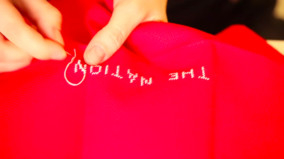
Leading Emirati artist Mohammad Kazem’s joint exhibition with Indian artist Chittrovanu Mazumdar and Dubai-based Italian Lebanese artist Cristiana de Marchi is a reflection of Dubai’s multicultural ethos and eclectic art scene. The show, titled “Soundless”, is curated by Malini Gulrajani, and it sets up an interesting dialogue between different artistic practices and perspectives.
Kazem is a pioneer of contemporary Emirati art, and is the only featured artist in the National Pavilion of the UAE at the Venice Biennial 2013. His works in this show include a set of pastel drawings with gradations of black on white paper from a series titled Soundless, and selected works from an ongoing series titled “Scratch on Paper” featuring various patterns scratched out with a sharp tool on white paper.
“In these works sound is present indirectly as a trace or a suggestion rather than an actual presence. In ‘Soundless’ the varying intensity of the colour evokes the imperceptible sound created by the movement of my pastel pencil on the paper. Similarly, the scratches are a visual representation of sound. I am a trained musician and to me the process of making these marks is like composing music. Each pattern is different and thus each piece has its own sound and mood,” he says. “On another level these artworks explore the temporal shifts and rhythms of nature such as the changing light and shade, and invite viewers to think about how every miniscule change in our environment has a ripple effect on the entire universe.”
de Marchi, who is a writer, poet, curator and artist, lived and worked in Lebanon for a decade before moving to Dubai seven years ago. Her work is influenced by the socio-political turmoil she has witnessed in the region. She likes to express herself through embroidery, and her piece, titled “Black” is a set of 30 black canvases. On each canvas she has embroidered with black thread an article from the Universal Declaration of Human Rights. Viewers need to get really close to see the words, but even then they cannot read them, because the words have been translated into Braille. The work makes a strong statement about the fact that we are blind to the abuse of the rights of women, children, the underprivileged and many others.
In another work, she has embroidered the word “Al Watan” (Arabic for The Nation) on a set of five canvases. Once again, the white-on-white embroidery and a second layer of threadwork make the letters barely visible. “In the Middle East, the term Al Watan evokes strong emotions associated with belonging, identity and self-affirmation. And it is often misused for political and ideological propaganda. This work plays with the explicit and implicit meaning of the term, which is like the scar of a wound in the collective consciousness,” de Marchi says.
She explores the concept further in a video titled “Doing and Undoing: The Nation”, where she is seen repeatedly embroidering and then removing the words “The Nation” from a piece of fabric. “Recent events have shown that the concept of a nation is not stable and must be constantly negotiated. This piece is a metaphor for the cycle of building, destroying and rebuilding of nations that is happening today, and it emphasises the fact that removing and untangling the thread is a difficult process,” she says.
Majumdar’s steel-and-light installations are different from Kazem and de Marchi’s subtle works, but they have a deeply spiritual quality. The artist was born in Paris and educated in the Indian city of Kolkata. His art reflects cultural influences from his French mother and his Indian father, who was one of Bengal’s most respected artists. He has been at the vanguard of contemporary Indian art for three decades and is best known for using light as a medium of expression.
His installations in this show feature rows of tiny hand-blown lights arranged on steel panels, with the intensity and colour controlled through a dimmer. “I am fascinated with the idea that the light of the stars we see is a very ancient light and perhaps by the time it reaches us the stars may be dead. The alternating rows of light and darkness in my pieces express the fact that light and darkness cannot exist without each other, and they seek to depict the poetry of light emanating from darkness and creating life. The accompanying soundtrack of intense primordial sounds underlines the similar relationship that exists between sound and the silences in between,” the artist says.
Majumdar is also displaying three videos that depict intimate stories about ordinary people. He has installed the videos inside metal boxes, inviting viewers to peep through a hole and watch the unfolding drama that comments on social, political, cultural and religious aspects of our society. The title of the videos, “Nights of Matryoshka Dreaming”, alludes to the many layers hidden within the fabric of society and the multiple public and private narratives that exist even in the most mundane lives.
Jyoti Kalsi is an arts enthusiast based in Dubai.
“Soundless” will run at Empty 10, Al Quoz, until April 4.




